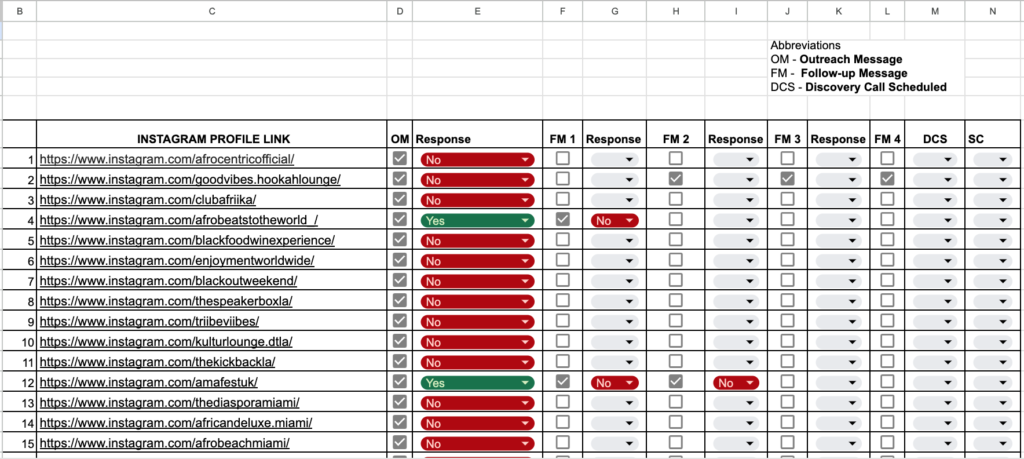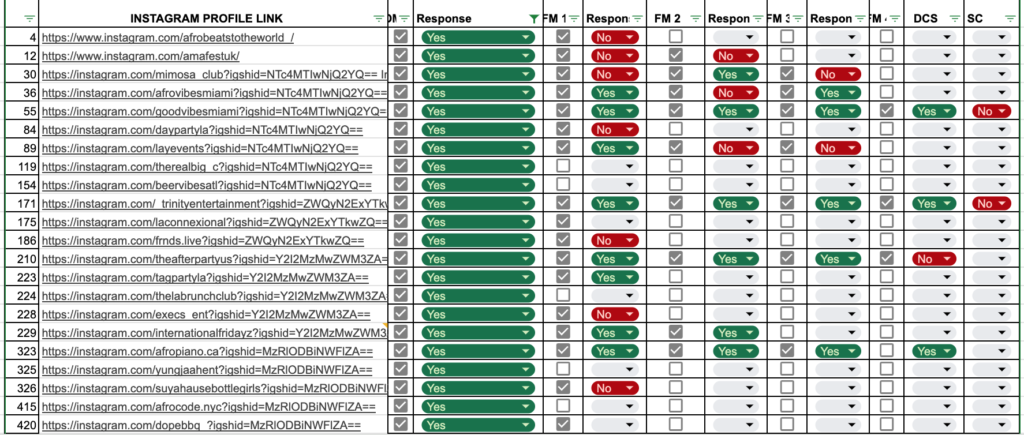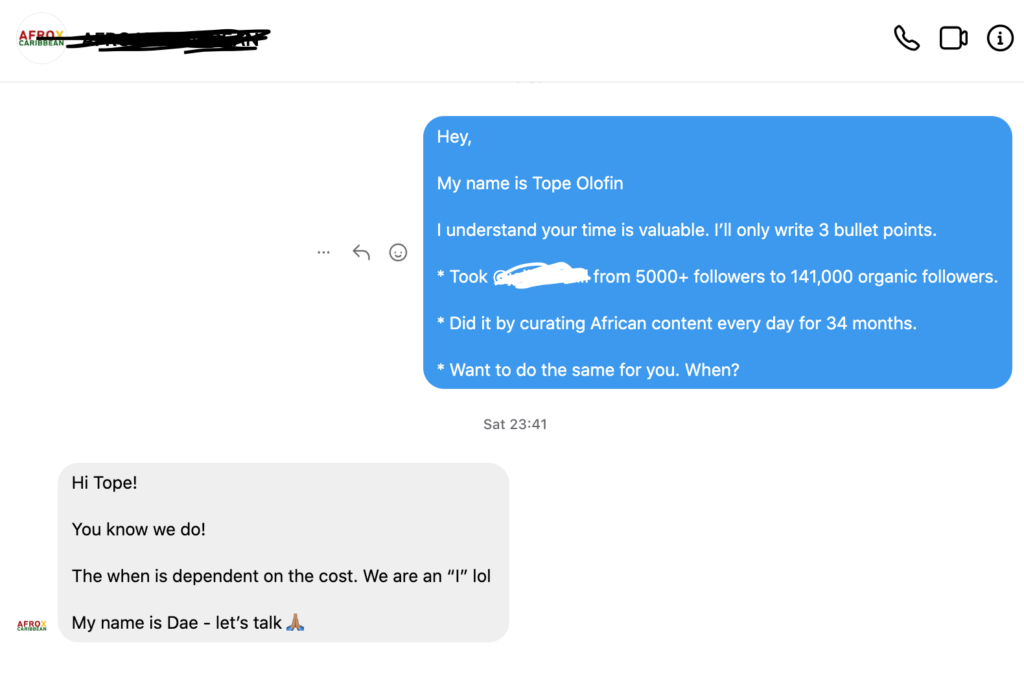I had this crazy idea to set up a content curation business that would generate anywhere from $40,000 to $60,000 per year. To hit the $40,000 mark, I only need 10 clients paying a minimum of $4,000 per year. So how exactly was I going to pull this off? What was going to be different? Would I have the ability to stay long enough to build it to a point where it becomes an actual business?
I tweeted about it in May but today, I’ll be sharing the steps I have taken to make this a reality
Unlike before where I just jumped into a business for the fun of it, I took my time to analyse the marketing and business assets I had. One that stood out was a client I had maintained from Aug 2020 to present day. What I did for his business was curate content using a content structure that complemented his party hosting business. Doing this consistently helped grow his Instagram following from 5000+ to over 100,000 followers.
At first, I brushed it off as Zuckerberg just giving us a lucky break, but after several months, I began to question if I had finally found something I could scale. Once my client started telling how people would ask what he was doing to grow his Instagram account, I decided to explore the possibility of building a content curation business.
The 4 Step Business Model
The business model was simple. It had only 4 steps:
- Identify an audience that can use curated content to promote their business. For me, businesses who hosted African themed parties in diaspora were at the top of the food chain.
- Send a brief outreach message that communicated what I wanted to do for them.
- Book a meeting to present my offer so that they could decide if the service is right for them.
- Close the sale and begin curating content for them.
Sounds like the perfect roadmap right? The only problem was it had not yet been tested. Because I am hell bent on sharing my journey, especially my losses, more than my successes, I will be taking you through my entire process, the mistakes I made and the lessons learned. This is a year long project and we are just 5 months in. There isn’t a happy or sad ending…yet, but I am hoping this might inspire someone to take the step to start that business, tweak that presentation and do big things to achieve great results.
Who your content curation business should target and why
Before embarking on this project, I had come to realise that knowing who to target when selling a product or service is totally different from truly understanding what they really want. This was the easy part. I knew who to target because I had spent the last 3 years documenting what I did for the only client I had. In a case where you have no client to study, make an assumption by starting with answering the question, “who really needs my product?”
For example, if I sold Software Quality Assurance Services, I would assume that people who might need my services would be companies that build software solutions or those who use custom software and web applications to engage with their customers or clients.
At the start of the project I already knew the following;
Who to target: Companies who hosted African themed parties in the US and Canada
What their needs were: Sell tickets to events
Where to find them: Instagram and Eventbrite
Because my solution is to curate content, I know you’re already wondering…”but how does that help sell event tickets?” Africans in diaspora are always on the lookout for wholesome African content, be it food, fashion, movies, lifestyle and travel. For a company hosting African themed-parties, the ability to curate this will build engagement, community, a place to forge connections and more importantly, it will be the perfect spot to promote African-themed events and SELL TICKETS to it.
The logic sounds simple and straightforward. It shouldn’t be hard to figure out but, the reality is I may never have figured this out if I hadn’t studied my client.
Crafting the ultimate outreach message
With this, the next step was to figure out what to say when I found them. The message needed to be brief enough to grab attention and pass the message but it also needed to be effective enough to make them give a favourable response. Being a believer in avoiding the need to reinvent the wheel, I went in search of the best cold email. I decided to go with the one written to secure an internship with Snapchat.
I tailored it to communicate my offer and came up with this.
| My name is Tope Olofin. I understand your time is valuable. I’ll only write 3 bullet points. * Took company X from yyy followers to yyyyy organic followers. * Did it by curating African content everyday for xx months. * Want to do the same for you. When? |
My next step was to get the message in front of the companies I wanted to work with. I had no budget for paid ads and sending multiple direct messages (DM) on Instagram is tedious and comes with the possibility of getting a ban. Let’s not skip the step where I would have to manually search for the companies. This was going to require a lot of time. So what did I do?
Tracking and measuring metrics and KPIs
I opted to send DMs and immediately hired 2 Sales Development Representatives (SDR). Their sole responsibility was to search, identify and contact these companies on Instagram and Eventbrite, nothing more. These are our target numbers
- Collate a list of 1000 US/Canada based companies that host African themed parties
- Select and contact 5 companies daily, through Instagram DM or email using the exact message template I customised.
Why only these tasks? For one, the work is monotonous and boring. I wanted to avoid work fatigue as much as possible. Also delegating these tasks gave me room to track and measure the responses and follow up messages that got the prospect to book a meeting with me.
For tracking our progress, I designed an outreach document. Here is a picture of what it looks like.

You’ll notice it has several tracking metrics but the most crucial ones for me were:
- The number of businesses contacted;
- The number of 1st responses gotten;
- The number of scheduled meeting;
- The number of sales meetings; and
- The number of sales closed.
What I was really doing was figuring out how to successfully move a prospect that we’ve contacted to respond. Once I figured that out, the next was to figure out how to get them to schedule a meeting with us and on down like that.
From May 15th till now, these are the numbers my SDRs have achieved.
- Collated a list of 544 companies
- Contacted 478 of them
- 28 responded.
This is a filtered view of the companies that responded

Results, achievements and lessons
The responses we’ve received range from, “we respectfully decline”, to “what are your rates”. Some inquired about the location of our business and some asked to set up a call to hear more. Asking to set up a call is the response I want because it moves us to the next step in the roadmap, booking a meeting where I can qualify the business and know for sure if they need and can afford to pay for the service.
One of the best responses I’ve received so far is…

It is important to understand why we were tracking the first responses to our outreach message. It is because it will help us understand;
- Understand the exact type of event business most likely to respond
- Fine tune the outreach message so I can get more of the type of response I wanted.
Receiving the type of responses that will lead to a booked meeting is still a work in progress and that is because we are yet to test variations of the initial outreach message. The goal is to reach 1000 event businesses first, then analyse the results before doing more of what is working and discarding what isn’t.
Once we receive the “let’s jump on a call” response, we proceed to book a call on zoom or google meet. Again this part can be tricky because they can either show up or NOT. So far we’ve had a total of 7 people ask to jump on a call but only 5 showed up. We must be doing something right here.
Here is a filtered view of people who have booked and showed up the meeting

Where we are at now
To better understand our conversion rates, I have designed the table below
| Actual Numbers | Conversion Rate | |
|---|---|---|
| Responses | 28 | 5.86% |
| Booked Meetings | 7 | 1.46% |
| Meeting show ups | 5 | 1.05% |
| Sales Closed | 0 | 0 |
We are currently at the stage where we are fine tuning the content of the meetings held. We believe this is crucial to discovering how best to close sales. Like I initially stated, my attempt at setting up a content curation business does not have a happy or sad ending yet. What we have left is 7 months. 7 months to figure out how to secure one or several other clients and I am here for it.
I’ll be updating this soon. Let’s hope I’ll have better numbers and more lessons to share with you.
Found this article on setting up a content curation business valuable? Don’t be selfish, share with someone else. Didn’t find it valuable, share anyway, that way people can call me out on my BS. Please and thank you!
You can always subscribe to my blog to make sure you don’t miss any business experiments I test out.

1 thought on “How to build a content curation business on Instagram”